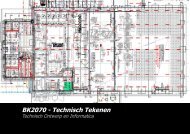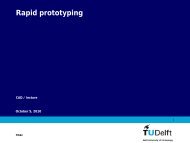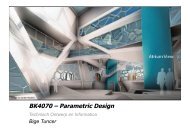many l<strong>in</strong>guistic qualities as well as eng<strong>in</strong>eer<strong>in</strong>g components (Lawson, 1990). As a professional, adesigner has to deal with three ma<strong>in</strong> categories of sciences, sometimes referred to as alpha, betaand gamma sciences. Alpha sciences deal with the subjective world of beauty and morality, asexpressed by the artistic, <strong>in</strong>tuitive soul. Beta sciences br<strong>in</strong>g <strong>in</strong> the objective world of facts andlogic, represented by the rational m<strong>in</strong>d. Gamma sciences consider the <strong>in</strong>terest of society andculture. The <strong>in</strong>tegration of these sciences makes the task of the designer more complex and at thesame time extraord<strong>in</strong>ary and unique. This means that the designer must have the skills to<strong>in</strong>tegrate the various discipl<strong>in</strong>es of knowledge (Sariyildiz, et. al., 2000).Presumably, the eng<strong>in</strong>eer<strong>in</strong>g considerations are easier to tackle, s<strong>in</strong>ce the methods of exactsciences are well developed. To deal with the l<strong>in</strong>guistic qualities <strong>in</strong> architectural design is not aneasy task, due to the imprecision of expressions used, and s<strong>in</strong>ce the qualities discussed, areconceptual rather than physical. Some examples of such conceptual qualities are large room,good overview, well lighted space etc. The question arises of how to model the knowledge forsuch conceptual qualities and how to automate that model<strong>in</strong>g process.Traditional models, such as Decision Support Systems and Expert Systems, have failed toprovide adequate support to users for many reasons. One important drawback is that thedevelopment of these systems is a quite time consum<strong>in</strong>g process. First, it is time consum<strong>in</strong>g togather the <strong>in</strong>formation and secondly, the programm<strong>in</strong>g part to form a consistent if-then rule base,is a time-consum<strong>in</strong>g activity. Gather<strong>in</strong>g <strong>in</strong>formation has always been and presumably will alwaysbe a time-consum<strong>in</strong>g activity, but the second part, the <strong>in</strong>formation process<strong>in</strong>g and knowledgemodel<strong>in</strong>g, can be significantly improved by automat<strong>in</strong>g this process. Secondly, the traditionalsystems are deductive rather then <strong>in</strong>ductive. These systems are based on explicit data,<strong>in</strong>formation and knowledge that is stored <strong>in</strong> the system (Turban, 1998). The drawback was thatthese systems could not deal with cases that were not dealt with <strong>in</strong> earlier cases, and were unableto deal with the uncerta<strong>in</strong>ty. In the complex environment related to build<strong>in</strong>g process, we areconfronted with uncerta<strong>in</strong>ty and new situations all the time. Yet, human be<strong>in</strong>gs are capable ofexist<strong>in</strong>g and successfully function<strong>in</strong>g <strong>in</strong> uncerta<strong>in</strong> environments. Human be<strong>in</strong>gs learn fromprevious situations, and are able to generalize, adapt and apply knowledge ga<strong>in</strong>ed over time toresolve a new situation. Examples of traditional models are Decision Support Systems (DSS) andExpert Systems (ES) with symbolic logic. These systems are <strong>in</strong>capable of conduct<strong>in</strong>g the abovementioned operations that humans can perform, s<strong>in</strong>ce they can be effective only <strong>in</strong> handl<strong>in</strong>gproblems characterized by exact and complete representations (Kasabov, 1996).From the above, it can be stated that the ma<strong>in</strong> objectives are to provide answers for two earlierposed questions, that is, (a) to systematize aspects that are related to public safety and comfort,and (b) to process <strong>in</strong>formation and model knowledge.1.3. MethodThis work is on the cutt<strong>in</strong>g edge between different discipl<strong>in</strong>es: between architecture and ArtificialIntelligence. From an architectural po<strong>in</strong>t of view, an <strong>in</strong>terest is taken from the way that peopleperceive space. Here the focus is on the relationship between user and built environment. Thiswas done by concentrat<strong>in</strong>g on underground stations as a built environment and perception ofpublic safety and comfort. These two components are important <strong>in</strong> perceiv<strong>in</strong>g underground- 4 -
spaces. There are also other aspects that play a role <strong>in</strong> perception, but <strong>in</strong> this work the decisionwas made to focus only on these two, and to show a way to deal with qualitative data <strong>in</strong> general.This work addresses the perception of public safety and comfort <strong>in</strong> underground stations,consider<strong>in</strong>g various determ<strong>in</strong>ants of these aspects. A conceptual model served as a ma<strong>in</strong>framework for this research. The research results of Steffen (1979, 1982), Pass<strong>in</strong>i (1984, 1992),Van Wegen and Van der Voordt (1991); Carmody and Sterl<strong>in</strong>g (1993), Korz (1998) wereimportant <strong>in</strong>put for the design of a conceptual model. In addition, the <strong>in</strong>terviews were carried outwith the architects who already had an experience <strong>in</strong> design<strong>in</strong>g underground stations. These<strong>in</strong>terviews were an important <strong>in</strong>put for the conceptual model as well. Each of the architects<strong>in</strong>terviewed 1 had their own approach and op<strong>in</strong>ion regard<strong>in</strong>g aspects related to user perception.Those <strong>in</strong>terviews confirmed earlier statement given by Hamel (1990), that the architect reliedma<strong>in</strong>ly on their <strong>in</strong>tuition when it came to solv<strong>in</strong>g the issues related to user associated aspects.The conceptual model served as a basis for the questionnaire design. This questionnaire was usedas a method to obta<strong>in</strong> <strong>in</strong>formation from the users regard<strong>in</strong>g different underground stations <strong>in</strong> theNetherlands. In such way, data was gathered on perception of different environments. This dataformed a base for model<strong>in</strong>g. A general name for study<strong>in</strong>g <strong>in</strong>formation acquisition, record<strong>in</strong>g,organization, retrieval, display and dissem<strong>in</strong>ation is referred to as <strong>in</strong>formation process<strong>in</strong>g.Knowledge is theoretical and <strong>in</strong>volves practical understand<strong>in</strong>g of a subject. Therefore, knowledgemodel<strong>in</strong>g can be def<strong>in</strong>ed as organiz<strong>in</strong>g <strong>in</strong>formation <strong>in</strong> some logical relationships (Slamecka,1994). The data used for <strong>in</strong>formation process<strong>in</strong>g is 'soft' data, represent<strong>in</strong>g different views ofusers regard<strong>in</strong>g different underground space environments. Therefore, there is a need for aspecific type of <strong>in</strong>formation process<strong>in</strong>g and knowledge model<strong>in</strong>g that would enable the model<strong>in</strong>gof soft data. Traditional techniques, such as statistical methods, have been used until now forsuch type of research. However, there are various drawbacks to this method (Taylor, 2000). Inaddition, the classical comput<strong>in</strong>g theories and models are often found <strong>in</strong>capable of deal<strong>in</strong>g withsuch uncerta<strong>in</strong> and imprecise <strong>in</strong>formation. This implies that there is a need for special techniquesnot only to numerically represent such qualities but more importantly to treat the data <strong>in</strong>responsible and the most suitable way. These techniques are known as soft comput<strong>in</strong>g techniques(Zadeh, 1994a; 1994b; Rojas, 1996) which are part of Artificial Intelligence.The ma<strong>in</strong> characteristic of soft comput<strong>in</strong>g techniques is their ability to deal with imprecise andill-def<strong>in</strong>ed data. The components of soft comput<strong>in</strong>g are considered to <strong>in</strong>clude fuzzy logic,artificial neural networks and genetic algorithms, evidence theory, probabilistic reason<strong>in</strong>g andmany others that could 'tolerate' uncerta<strong>in</strong> and imprecise <strong>in</strong>formation (Chen, Y<strong>in</strong>g and Cai, 1999).For this particular research, <strong>in</strong> respect to <strong>in</strong>formation process<strong>in</strong>g and knowledge model<strong>in</strong>g, twoparticular techniques are of <strong>in</strong>terest. These are fuzzy logic and neural network theory. Fuzzy logicaims at deal<strong>in</strong>g with uncerta<strong>in</strong>ty and imprecision of a particular k<strong>in</strong>d - fuzz<strong>in</strong>ess <strong>in</strong> concepts, withwhich people usually th<strong>in</strong>k and reason <strong>in</strong> their decision-mak<strong>in</strong>g and problem-solv<strong>in</strong>g process.With fuzzy logic, the imprecision of data can be dealt with <strong>in</strong> a similar way to how humans usesuch data. Artificial neural networks model to some extent the human bra<strong>in</strong>, and simulates its1 Interviews were carried out with ir. Moshé Zwarts (February 1999), ir. L.I. Vákár (April 1999), ir. Theo Fikkers(December 1998) and lately ir. Harry Volker (who was consulted on various occasions). The first three architects hadan experience <strong>in</strong> design<strong>in</strong>g underground spaces, which was of great value for this research. The architect, H. Volker,has been a practis<strong>in</strong>g architect for more than 30 years and his suggestions were an important contribution to thisresearch, as the member of the chair TO&I.- 5 -
- Page 5: ContentsChapter 1 Introduction 11.1
- Page 9 and 10: CHAPTER 1Introduction1.1. Backgroun
- Page 11: In the Netherlands, most publicly u
- Page 15 and 16: The information to be processed is
- Page 17 and 18: CHAPTER 2From spatial planing to pe
- Page 19 and 20: In short, utilizing underground spa
- Page 21 and 22: Up until now it has been shown that
- Page 23 and 24: the information but also the desire
- Page 25 and 26: Another important conclusion is rel
- Page 27 and 28: develop a generic method to model t
- Page 29 and 30: In order to define the working area
- Page 31 and 32: spatialenvironmenthuman beingmental
- Page 33 and 34: CHAPTER 3Identification of the mode
- Page 35 and 36: case of emergency. Interestingly, t
- Page 37 and 38: judgement and experience of space.
- Page 39 and 40: Figure 4: View over the platform. U
- Page 41 and 42: •= Layout including both spatial
- Page 43 and 44: comfort seems to fulfill a biologic
- Page 45 and 46: Spatial CharacteristicsSpatial char
- Page 47 and 48: material/coloroverviewconstructione
- Page 49 and 50: Another aspect is the transparency
- Page 51 and 52: there are three key issues that are
- Page 53 and 54: •= the questions were closed, whi
- Page 55 and 56: CHAPTER 4Theoretical background on
- Page 57 and 58: some way or other has "memory". Add
- Page 59 and 60: XoWEIGHTSArtificial NeuronX1X2 Wj2.
- Page 61 and 62: Xthe inputspace(domain)inputsoutput
- Page 63 and 64:
the text. This implies that general
- Page 65 and 66:
numerical values. A variable is cal
- Page 67 and 68:
artificial neural networks versus f
- Page 69 and 70:
Figure 11: The inverse quadratic fu
- Page 71 and 72:
part of the data as receptive field
- Page 73 and 74:
The main feature of expert systems
- Page 75 and 76:
• Use logical (deductive) reasoni
- Page 77 and 78:
CHAPTER 5Experimental research: Cas
- Page 79 and 80:
Figure 2: The old and new situation
- Page 81 and 82:
Figure 8, 9: Entrance to platform (
- Page 83 and 84:
Beurs/Churchillplein station is sit
- Page 85 and 86:
Figure 22, 23: The main entrance to
- Page 87 and 88:
Table 2: Aspects related to comfort
- Page 89 and 90:
5.3.3. ResponseFrom 27 May until 30
- Page 91 and 92:
7060605050404030302020Percentage100
- Page 93 and 94:
5.4.5. Way of orientingIn Figures 4
- Page 95 and 96:
Table 7: Perception of comfort in t
- Page 97 and 98:
CHAPTER 6Experimental research by k
- Page 99 and 100:
of input information i.e., the case
- Page 101 and 102:
Figure 3: Training results for rang
- Page 103 and 104:
Experiment 2aThe first 28 parameter
- Page 105 and 106:
formed by this knowledge model. In
- Page 107 and 108:
Table 4: Hierarchical order of sens
- Page 109 and 110:
Table 8: Hierarchical order of sens
- Page 111 and 112:
information structured as a knowled
- Page 113 and 114:
elationship it is understood to be
- Page 115 and 116:
10.80.60.40.201 4 7 10 13 16 19 22
- Page 117 and 118:
wilhelmina11.624.164.3wilhelmina36.
- Page 119 and 120:
wilhelmina6.720.373rijswijkblaak22.
- Page 121 and 122:
This study considered both metro an
- Page 123 and 124:
Some specific conclusions can be ma
- Page 125 and 126:
wilhelminarijswijkblaakbeurs9.62.59
- Page 127 and 128:
CHAPTER 7Conclusions and recommenda
- Page 129 and 130:
Furthermore, this research is also
- Page 131 and 132:
Additional efforts to improve knowl
- Page 133 and 134:
integrated computational intelligen
- Page 135 and 136:
Appendix A: Questionnaire for Blaak
- Page 137 and 138:
DEEL 3:HET VINDEN VAN DE WEGVraag 1
- Page 139 and 140:
DEEL 8:VERLICHTINGVraag 26: In hoev
- Page 141 and 142:
Appendix B : Learning based data an
- Page 143 and 144:
For further explanation regarding s
- Page 145 and 146:
ReferencesAlsop Architects (2001).
- Page 147 and 148:
COB (2000). Jaarverslag 1999. Centr
- Page 149 and 150:
Leonard J.A., Kramer M.A., and Unga
- Page 151 and 152:
Van Wegen, H. B. R. and Van der Voo
- Page 153 and 154:
SummaryThe intensification, combina
- Page 155 and 156:
aspects, which is derivation of dep
- Page 157 and 158:
SamenvattingBelevingsaspecten van O
- Page 159 and 160:
krachtige combinatie te zijn voor h
- Page 161 and 162:
AcknowledgmentsAfter formal discuss
- Page 163 and 164:
About the authorSanja Durmisevic wa
- Page 165 and 166:
BibliographyJournal publicationsDur
- Page 167:
Ciftcioglu Ö., Durmisevic S. and S





